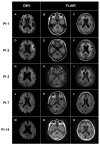Heterogenous Genetic, Clinical, and Imaging Features in Patients with Neuronal Intranuclear Inclusion Disease Carrying NOTCH2NLC Repeat Expansion
- PMID: 37371433
- PMCID: PMC10296744
- DOI: 10.3390/brainsci13060955
Heterogenous Genetic, Clinical, and Imaging Features in Patients with Neuronal Intranuclear Inclusion Disease Carrying NOTCH2NLC Repeat Expansion
Abstract
Neuronal intranuclear inclusion disease (NIID) is a neurodegenerative disorder that is caused by the abnormal expansion of non-coding trinucleotide GGC repeats in NOTCH2NLC. NIID is clinically characterized by a broad spectrum of clinical presentations. To date, the relationship between expanded repeat lengths and clinical phenotype in patients with NIID remains unclear. Thus, we aimed to clarify the genetic and clinical spectrum and their association in patients with NIID. For this purpose, we genetically analyzed Japanese patients with adult-onset NIID with characteristic clinical and neuroimaging findings. Trinucleotide repeat expansions of NOTCH2NLC were examined by repeat-primed and amplicon-length PCR. In addition, long-read sequencing was performed to determine repeat size and sequence. The expanded GGC repeats ranging from 94 to 361 in NOTCH2NLC were found in all 15 patients. Two patients carried biallelic repeat expansions. There were marked heterogenous clinical and imaging features in NIID patients. Patients presenting with cerebellar ataxia or urinary dysfunction had a significantly larger GGC repeat size than those without. This significant association disappeared when these parameters were compared with the total trinucleotide repeat number. ARWMC score was significantly higher in patients who had a non-glycine-type trinucleotide interruption within expanded poly-glycine motifs than in those with a pure poly-glycine expansion. These results suggested that the repeat length and sequence in NOTCH2NLC may partly modify some clinical and imaging features of NIID.
Keywords: GGC repeat expansion; NOTCH2NLC; clinical presentations; genotype–phenotype correlation; neuroimaging; neuronal intranuclear inclusion disease.
Conflict of interest statement
The authors declare no conflict of interest.
Figures



References
-
- Ishiura H., Shibata S., Yoshimura J., Suzuki Y., Qu W., Doi K., Almansour M.A., Kikuchi J.K., Taira M., Mitsui J., et al. Noncoding CGG repeat expansions in neuronal intranuclear inclusion disease, oculopharyngodistal myopathy and an overlapping disease. Nat. Genet. 2019;51:1222–1232. doi: 10.1038/s41588-019-0458-z. - DOI - PubMed
-
- Sone J., Mitsuhashi S., Fujita A., Mizuguchi T., Hamanaka K., Mori K., Koike H., Hashiguchi A., Takashima H., Sugiyama H., et al. Long-read sequencing identifies GGC repeat expansions in NOTCH2NLC associated with neuronal intranuclear inclusion disease. Nat. Genet. 2019;51:1215–1221. doi: 10.1038/s41588-019-0459-y. - DOI - PubMed
Grants and funding
- JP23dm0207060/Japan Agency for Medical Research and Development
- JP23dm0207073/Japan Agency for Medical Research and Development
- JP23dk0207066/Japan Agency for Medical Research and Development
- 22H02980/Japan Society for the Promotion of Science
- 21FC0201/Japanese Ministry of Health, Labor, and Welfare
LinkOut - more resources
Full Text Sources

